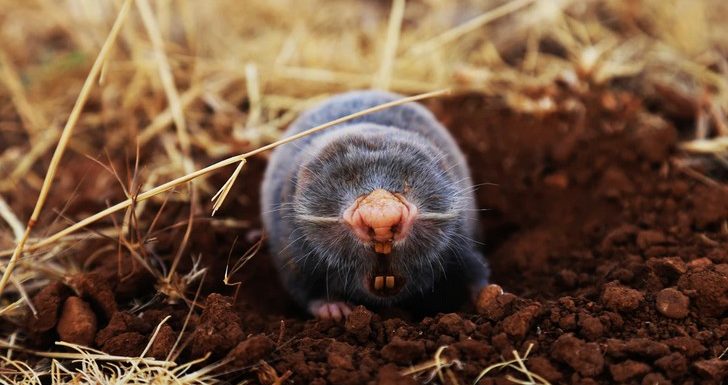
To control moles and gophers successfully, you first need to be able to tell the difference between them so you know what you’re dealing with.
Table of Contents
Differences Between Moles and Gophers
Moles usually grow no larger than 8″, and their coats are dark brown or black. Gophers are roughly 6–12″ long, with ears that are set toward the back of the head and a coat that ranges from dark brown to light gray in color. The easiest way to distinguish between them is the nose: moles have long, bare snouts, whereas gophers’ noses are more similar to those of rodents such as the woodchuck or the squirrel.
Gophers, not moles, are usually responsible for destruction in a vegetable garden. Moles prefer to eat grubs (especially Japanese beetle grubs) and for that reason are often considered beneficial to lawns and gardens—with the exception of the hills they build.
Signs of a Mole or Gopher Problem
Gophers form fan-shaped burrows, while moles form round, volcano-shaped burrows that are usually plugged at the top. Gopher mounds are typically larger; moles build more numerous, smaller mounds, as well as strips of bare or raised earth called runways, where they do much of their feeding. Gopher tunnels, on the other hand, aren’t usually visible from the surface.
How to Identify High-Traffic Burrows
- To identify the paths of a gopher tunnel, push a metal rod into the earth near a burrow until you feel the rod give. The rod giving way is a sign that you’ve punched your way through the walls of the gopher’s tunnel. Mark each pathway for later reference.
- High-traffic mole runways are easier to detect because they’re often visible on the surface. To learn which runway is getting the most traffic, simply cave the tunnel in with your foot and wait 24 hours. If the runway has been repaired within that time, you can bet that moles are using it.
Trapping Moles
- Victor® and Nash® both make quality mole traps. Wash the traps to remove human smells (which will cause the mole to sense danger), and handle them with clean gloves.
- Push the traps into the earth over the runway that you’ve observed the mole using most. Set the traps as delicately as possible to avoid alarming the mole.
- Check the traps on a daily basis. If a mole isn’t caught within two or three days, chances are you’ve scared it away from that particular runway. You’ll have to find another and set the traps again.
Fortunately, moles are solitary creatures, so once you’ve caught one, you shouldn’t see any more for a while.
Trapping Gophers

- Wash the trap with soap and water to remove any smells, making sure not to touch the traps with anything but clean gloves.
- Push a post into the ground near the burrow. Tie a piece of twine from the post to the trap to ensure that the gopher doesn’t pull the trap deeper into its burrow.
- Set the traps carefully, according to the manufacturer’s instructions, and be gentle with the mound. If you have to excavate part of the tunnel to set the trap, make sure to cover it back up with dirt to prevent light from coming through. Light will alert the gopher to a possible intrusion.
- Try to find the two main runways leading out from the burrow. Typically the runways head in opposite directions from each other away from the hole—as described earlier, use a metal rod to find them. Set traps in both runways heading away from the burrow.
- If the gopher isn’t captured within 3–4 days, find another burrow and repeat steps 1–4 until you get it.
Like moles, gophers are solitary creatures, so capturing one means you’ve captured them all—from that particular network of burrows, anyway.
Flooding Burrows
If traps don’t work, you can also try flooding a mole or gopher out of its burrow.
- Have a shovel ready beforehand to kill the animal if it tries to escape after getting flooded out of its burrow, Though it may seem cruel, one sharp blow to the head is a quick, humane way to kill a mole or gopher.
- Stick a garden hose into one of the tunnels and turn the water on. Let the water run for 10–15 minutes, watching the other tunnels closely.
- Occasionally, a gopher or mole won’t make it out of a flooded burrow alive. But if it does, try to chase it and use the shovel to kill it.
Fumigating Burrows
Gas cartridges, also known as smoke bombs, remove oxygen from a burrow and force moles and gophers to flee, if they make it out alive at all. Pick up a pack of gas cartridges by Giant Destroyer or Revenge, and then do the following:
- Find a fresh mound of dirt, and dig down until you have a clear opening. Make sure all other openings are closed.
- Insert the fuse into the gas cartridge, leaving two or three inches of the fuse exposed.
- Light the fuse and drop the cartridge into the opening.
- When the cartridge begins smoking, cover the opening completely with dirt. Move away from the site—the fumes from the cartridge should not be inhaled.
Keeping Moles and Gophers Away
To keep moles and gophers from burrowing into your yard or garden, surround the area you wish to protect with 1/2″–mesh chicken wire buried at least 24″ inches below ground and standing roughly 24″ inches above ground.

